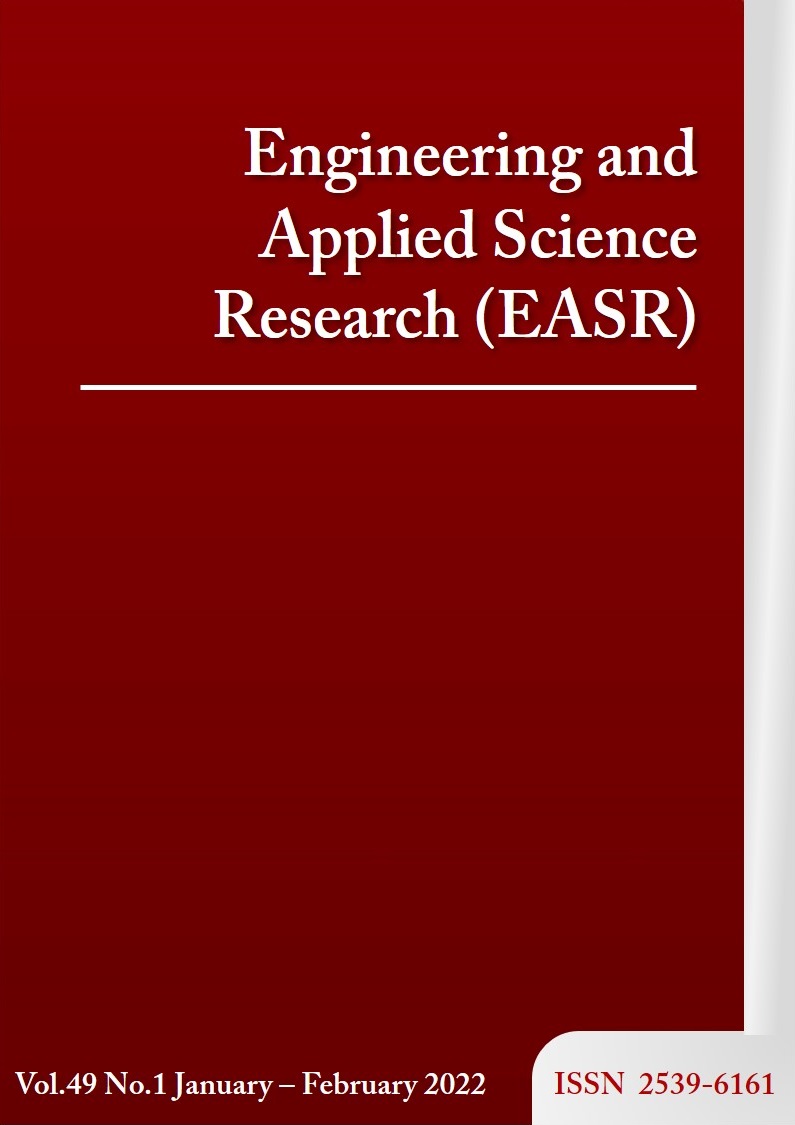Workstation improvement to reduce muscle aches during silk degumming and dyeing in silk weaving profession in Nakhon Ratchasima province
Main Article Content
Abstract
Silk degumming and dyeing are considered high ergonomics risk procedures for workers because they have to stand working, bent and perk their faces, twist their bodies, and wrists during the processes. These affect the Surface Electromyography (sEMG) especially the lower back which is a significant problem affecting the production efficiency, and workers' health and safety. This study aims at improving the workstation to reduce muscle aches during silk degumming and dyeing in the silk weaving procession in Nakhon Ratchasima province. The data was collected using anthropometric measurements for standing work on 400 workers in silk degumming and dyeing. The data was used to improve the degumming and dyeing aid equipment. The study found that degumming and dyeing using the traditional degumming and dyeing equipment gave a higher sEMG rate and amplitude of upper trapezius muscles than the degumming and dyeing aid equipment. This meant higher tissue load and muscular fatigue. This could reduce the time for the silk degumming and dyeing at the rate of 30.09%.
Article Details
This work is licensed under a Creative Commons Attribution-NonCommercial-NoDerivatives 4.0 International License.
References
Kaur J, Singh AD. Ergonomic evaluation of female working in small scale handicraft industries of Patiala district of Punjab. Am Res J Sports Med. 2018;1(1):1-8.
Motamedzade M, Moghimbeigi A. Musculoskeletal disorders among female carpet weavers in Iran. Ergon. 2012;55(2):229-36.
Kumar P, Muthukumar K. Industrial health hazards in textile industry. J Autom Automobile Eng. 2018;3(3):5-9.
Ramdan IM, Candra KP, Fitri AR. Factors affecting musculoskeletal disorder prevalence among women weavers working with handlooms in Samarinda, Indonesia. Int J Occup Saf Ergon. 2020;26(3):507-13.
Pandit S, Kumar P, Chakrabarti D. Ergonomic problems prevalent in handloom units of North East India. Int J Sci Res Publ. 2013;3(1):1-7.
Bunchu S, Rakphong N. Wisdom of Isan Indigenous Thai Silk Yarn. Bangkok: Department of Sericulture, Ministry of Agriculture and Cooperatives; 2012. (In Thai)
Integrated Provincial Group Management Committee Lower Northeast Provinces 1. Lower Northeastern Province Development Group Plan 1 (2018-2021); Revised Edition 2019. Thailand: Group Lower Northeast Provinces 1; 2019. (In Thai)
Praveen Kumar M, Mugundhan K, Visagavel K. Occupational health & safety in textile industry. Int J Res Eng Tech. 2014;3(11):168-72.
Damle PG, Wani VP, Patil ID. Ergonomic considerations in workstation design for deburring process at mat manufacturing. Int J Innovat Eng Tech. 2015;6:100-4.
Tompa E, Dolinschi R, Natale J. Economic evaluation of a participatory ergonomics intervention in a textile plant. Appl Ergon. 2013;44(3):480-7.
Narayanan A, Mathew C, Baby VY. Improvement of ergonomic factors that affects employees in a textile industry. Int J Eng Sci Innovat Tech. 2013;2(1):276-82.
Naz H, Kwatra S, Ojha P. Prevalence of musculoskeletal disorders among handloom weavers of Uttarakhand: an ergonomic study. Int J Appl Nat Sci. 2015;7(1):102-5.
Singh AK, Meena ML, Chaudhary H, Dangayach GS. Ergonomic evaluation of cumulative trauma disorders among female carpet weavers in India: guidelines to an effective sustainability in work system design. Int J Hum Factors Ergon. 2018;5(2):129-50.
Madschen S.M.O.S.S. Tambun. Ergonomics risk analysis in Ulos weaving workers in the Martimbang and Kebun Sayur village Pematang Siantar city. Adv Health Sci Res. 2017;6:402-9.
Rithinyo M, noyming S, Loatong P. Factors affecting musculoskeletal disorders in workers of the degumming and dyeing process of silk weaving profession in Nakhonratchasima province. The Journal of KMUTNB. 2021;31(4):125-37.
Kuorinka I, Jonsson B, Kilbom A, Vinterberg H, Biering-Sorensen F, Andersson G, et al. Standardised Nordic questionnaires for the analysis of musculoskeletal symptoms. Appl Ergon. 1987;18(3):233-7.
Md Deros B, Yusoff A, Ismail SJ, DI Daruis D. Optimizing workstation design for standing work system in an electronics assembly work. Iranian J Publ Health. 2016;45(1):17-24.
Merletti R, Parker P. Electromyography: physiology, engineering and noninvasive applications. New Jersey: John Wiley & Sons; 2004.
Sogaard K, Olsen HB, Blangsted AK, Sjogaard G. Single motor unit firing behavior in the right trapezius muscle during rapid movement of right or left index finger. Front Hum Neurosci. 2014;8:881-9.
Picavet HSJ, Schouten J. Musculoskeletal pain in the Netherlands: prevalences, consequences and risk groups, the DMC3-study. Pain. 2003;102(1-2):167-78.
Mathiassen SE, Winkel J, Hagg GM. Normalization of surface EMG amplitude from the upper trapezius muscle in ergonomic studies - a review. J Electromyogr Kinesiol. 1995;5(4):197-226.
Bao S, Mathiassen SE, Winkel J. Normalizing upper trapezius EMG amplitude: comparison of different procedures. J Electromyogr Kinesiol. 1995;5(4):251-7.
Jonsson B. Measurement and evaluation of local muscular strain in the shoulder during constrained work. J Hum Ergol. 1982;11(1):73-88.
Tarafder N. Study of ergonomics in textile industry. J Mech Robot. 2019;4(3):32-40.
Boschman JS, Frings-Dresen M, van der Molen HF. Use of ergonomic measures related to musculoskeletal complains among constitution workers: a 2-year follow-up study. Saf Health Work. 2015;6(2):90-6.
Heizer J, Render B. Principles of operations management. 6th ed. New Jersey: Prentice Hall; 2006.
Ramdass K. The implementation of ergonomics as a sustainable competitive advantage in the clothing industry. Proceedings of PICMET '13: Technology Management in the IT-Driven Services (PICMET); 2013 Jul 28 - Aug 1; San Jose, USA. New York: IEEE; 2013.
Mukund A, Amanprasad BH, Kvs RR, Subramanya KN, Principal V. Ergonomic evaluation of the workstations in a garment manufacturing industry-an exploratory study. Int J Mech Prod Eng. 2014;2(4):54-61.



